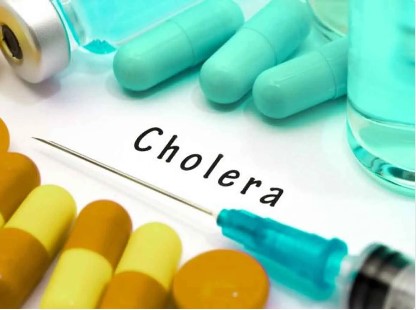Health
Why We Rename Monkeypox – WHO
Published
3 years agoon
By
Editor
The World Health Organisation has said it will start using a new preferred term, ‘mpox’, as a synonym for monkeypox.
The change of name is following a series of consultations with global experts and both names will be used simultaneously for one year while “monkeypox” is phased out, according to the WHO.
In a press statement issued on Monday and made available to The PUNCH, it said when the outbreak of monkeypox expanded earlier this year, racist and stigmatising language online, in other settings, and in some communities was observed and reported to the WHO.
The statement read in part, “In several meetings, public and private, a number of individuals and countries raised concerns and asked the WHO to propose a way forward to change the name.
“Assigning names to new and, very exceptionally, to existing diseases is the responsibility of the WHO under the International Classification of Diseases and the WHO Family of International Health Related Classifications through a consultative process which includes WHO Member States.
READ ALSO: WHOWhy Nigerians Suffer Poor Healthcare – WHO
“The WHO, in accordance with the ICD update process, held consultations to gather views from a range of experts, as well as countries and the general public, who were invited to submit suggestions for new names.”
Based on these consultations, and further discussions with the WHO’s Director-General Dr. Tedros Ghebreyesus, the WHO recommends the adoption of the new synonym mpox in English for the disease and mpox will become a preferred term, replacing monkeypox, after a transition period of one year.
“This serves to mitigate the concerns raised by experts about confusion caused by a name change in the midst of a global outbreak. It also gives time to complete the ICD update process and to update WHO publications.
“The synonym mpox will be included in the ICD-10 online in the coming days. It will be a part of the official 2023 release of ICD-11, which is the current global standard for health data, clinical documentation and statistical aggregation.
“The term “monkeypox” will remain a searchable term in ICD, to match historic information.
“Considerations for the recommendations included rationale, scientific appropriateness, extent of current usage, pronounceability, usability in different languages, absence of geographical or zoological references, and the ease of retrieval of historical scientific information.
“Usually, the ICD updating process can take up to several years. In this case, the process was accelerated, though following the standard steps.
“Various advisory bodies were heard during the consultation process, including experts from the medical and scientific and classification and statistics advisory committees which was constituted of representatives from government authorities of 45 different countries.
READ ALSO: WHO Proffers Solution To Ending Tuberculosis In Nigeria
“The issue of the use of the new name in different languages was extensively discussed. The preferred term mpox can be used in other languages. If additional naming issues arise, these will be addressed via the same mechanism. Translations are usually discussed in formal collaboration with relevant government authorities and the related scientific societies.
“The WHO will adopt the term mpox in its communications, and encourages others to follow these recommendations, to minimise any ongoing negative impact of the current name and from adoption of the new name,” it added.
You may like


Tobacco Kills 1.3 Million Non-smokers Yearly — WHO


Nigeria, Seven Others May Face HIV Drug Shortages – WHO


Following Trump, Argentina Quits World Health Organization


WHO Reacts To US Withdrawal From Organisation


Egypt Joins List Of Countries Certified By WHO As Malaria-free [See Full List]


Fake Diabetes, Weight Loss Drugs Pose Health Risks, WHO Warns
Health
LASG FLags Off Polio Outbreak Response Campaign
Published
6 months agoon
January 20, 2025By
Editor
The Lagos State Government, through the Lagos State Primary Health Care Board, has launched the 2025 Polio Outbreak Response Campaign, reaffirming its commitment to eradicating polio and safeguarding the health of its children.
The ceremony, held at the Simpson Primary Healthcare Centre, was led by the First Lady of Lagos State, Dr. (Mrs.) Claudiana Ibijoke Sanwo-Olu, represented by Mrs. Widad Jumoke Mustafa, a member of the Committee of Wives of Lagos State Officials (COWLSO).
In her address, the First Lady emphasised the state government’s proactive measures to keep Lagos polio-free, highlighting the critical importance of the campaign in preventing the debilitating effects of poliomyelitis, which can result in paralysis or death.
READ ALSO: IMPEACHMENT: Lagos Ex-Speaker, Obasa’s ‘Sins’ Revealed
The First Lady also called on parents, community leaders, and stakeholders to support the campaign by ensuring eligible children are vaccinated.
Targeting children aged 0-59 months, vaccination teams will administer the Oral Polio Vaccine (OPV) to prevent virus transmission.
Dr. Kemi Ogunyemi, the Special Adviser on Health, expressed gratitude to Lagosians for their continued cooperation in the fight against polio. While appreciating all healthcare workers and partners for their services, Mrs. Ogunyemi encouraged parents to present their children and wards for the exercise.
Also speaking, the Chairman of Lagos Mainland Local Government, Mrs. Omolola Rashidat Essien opined that Immunization is key in ensuring that children are kept safe from polio and other vaccine preventable diseases.
Dr. Abimbola Bowale, the Supervising Permanent Secretary, Lagos State Primary Health Care Board, who also spoke at the event, underscored the life-saving importance of immunization.
“All children aged 0-59 months need multiple doses of the polio vaccine to ensure full protection. Any child missed represents a potential risk for the poliovirus to spread. The vaccine is safe, effective, and crucial in keeping our communities polio-free,” he stated.
Dr. Bowale also outlined several strategies to ensure the success of the campaign, including fixed post teams stationed at primary healthcare centres and public health facilities, house-to-house visits, and a transit strategy to reach special locations such as places of worship, schools, motor parks, and other public venues.
The event concluded with Dr. (Mrs.) Claudiana Ibijoke Sanwo-Olu officially launched the campaign, marking a renewed effort to maintain Lagos State’s polio-free status.

The Lagos state suspected cholera cases have risen to 421.
The Commissioner for Health, Akin Abayomi disclosed this on his Instagram handle @profakinabayomi on Saturday.
“As of June 20, 2024, an additional four suspected cholera cases have been reported, as illustrated in the accompanying graph,” he wrote.
He noted that the Emergency Operations Centre in collaboration with all relevant partners is actively engaged in contact tracing, community-based surveillance, awareness campaigns, sample testing, and ensuring that confirmed cholera cases receive appropriate medical treatment.
READ ALSO: Two Suspects Arrested For Stealing Car From Mosque During Juma’at Prayer
On Friday, the commissioner confirmed 35 cases out of the 417 suspected cases and 24 deaths across 20 Local Government Areas in the state.
The cases were reported from Agege, Badagry, Ikeja, Mushin, Ajeromi-Ifelofun, Epe, Ikorodu, Ojo, Alimosho, and Eti-Osa.
Others were Kosofe, Oshodi-Isolo, Amuwo-Odofin, Ibeju-Lekki, Lagos Island, Shomolu, Apapa, Ifako-Ijaiye, Lagos mainland, and Surulere.
Cholera is a food and water-borne disease caused by ingesting the bacteria— Vibrio cholerae — in contaminated water and food. Cholera can cause severe acute watery diarrhoea, and the severe forms of the disease can kill within hours if left untreated.
In Nigeria, cholera is an endemic and seasonal disease, occurring annually mostly during the rainy season and more frequently in areas with poor sanitation.
READ ALSO: Police Arrest 28yr Old Suspected Cultists, Recover Gun In Delta Community
The World Health Organisation on Thursday announced a spike in cholera in several regions of the world, with almost 195,000 cases and over 1,900 deaths reported in 24 countries since the start of 2024.
WHO said the Eastern Mediterranean Region reported the highest number of cases, followed by the African Region, the Region of the Americas, the Southeast Asia Region, and the European Region.
The global health body, however, noted that there are no reported cases in the Western Region, according to its bulletin released on Wednesday.
It said it exhausted its global stockpile of Oral Cholera Vaccines by March but was able to exceed “the emergency target of five million doses in early June for the first time in 2024.”

By Silver Yeibake
Autism, commonly known as Autism Spectrum Disorder (ASD), is a neurodevelopmental disorder that affects communication, social interaction, and behavior. Autism is referred to as a spectrum condition since it can manifest in a variety of symptoms and abilities. While the actual cause of autism is unknown, evidence suggests that genetic and environmental factors interact to influence its development.
The risk factors include a sibling with autism, advanced age of parents, exposure to certain air pollutants and pesticides before birth, extreme prematurity, mothers with diabetes, immune system disorders or obesity, any difficulty with delivery leading to deprivation of oxygen to the baby’s brain, fever during pregnancy, lack of certain vitamins minerals during pregnancy, and certain genetic conditions, such as Down, fragile X, and Rett syndromes.
“Risk factors can not on their own cause a disease. However, they can increase the likelihood of that disease in a person.”
It is important to know that contrary to trending claims online, there is no scientific or medical evidence that vaccines or consumption of sugar are risk factors for autism.
READ ALSO: Kidney Stones: What You Need To Know
Autism is defined by difficulties in social interaction and communication. Individuals with autism may struggle to grasp social cues, maintain eye contact, and engage in typical back-and-forth conversations. Some people may also engage in meaningless, repetitive actions, such as hand-flapping or rocking, and have strong interests in specific areas.
It is essential to remember that autism is a lifelong diagnosis, but with early intervention and adequate care, people with autism can live fulfilling lives.
Autism treatment frequently includes behavioral therapy, speech therapy, occupational therapy, and social skills training. Each individual with autism is unique, thus interventions should be tailored to meet their personal needs and strengths.
In spite of the difficulties that autism can cause, many people with autism possess unique talents and abilities. Some people may succeed in fields such as music, art, mathematics, or programming, thus it is important for society to acknowledge and honor the qualities and achievements of people with autism.
In summary, autism is a complicated and diverse disorder that affects individuals in various ways. By raising autism knowledge, understanding, and acceptance, we can build a more inclusive society in which people with autism can thrive and attain their full potential.
Dr. Yeibake, Weriwoyingipre Silver.
Senior Registrar,
Faculty Of Pediatrics,
WACP
- Congress Newspaper @4: X-Raying The Evolution Of Media In Ijaw Nation
- JUST IN: Psychiatric Hospital Staff Shot Dead In Benin
- Supreme Court: Jubilant Supporters Stunned, Locked Out Of Edo Govt House [PHOTOS]
- Gunmen Invade Catholic Seminary School In Edo, Kill One, Abduct Three
- Pastor Arraigned Over Alleged Rape Of Married Woman In Edo
- OPINION: BAT Rejects Trump’s Amazing Offer
- Nurses Reject NSIWC Circular On Allowances
- LASIEC Releases Validated Candidates’ List Gor Lagos LG Polls
- Lagos Police Deploys 30,000 Officers For LG Polls
- How Law Student’s Inability To Pay N120,000 Caused Her Death At UNIZIK
About Us
Trending

 News4 days ago
News4 days agoBREAKING: FG Officially Releases Age Limit For Admission Into Tertiary Institutions

 Metro2 days ago
Metro2 days agoMysterious Bird Found Inside Auchi Poly Lecturer’s Office, Killed

 News4 days ago
News4 days agoOPINION: APC’s Leprosy Versus ADC’s Scabies

 Politics3 days ago
Politics3 days ago‘The Man I Defeated 32 Years Ago Hasn’t Forgiven Me’ – Ita-Giwa Laments Discrimination Against Women In Politics

 News4 days ago
News4 days agoFlash Flood Warning: Sokoto, Edo, Akwa Ibom, 17 Other States At Risk In July — NiMet

 Politics3 days ago
Politics3 days ago97 Lawyers Line Up To Defend ADC, Mark, Aregbesola Against APC’s ‘Fake Lawsuit’

 Entertainment5 days ago
Entertainment5 days agoOPINION: From The North, ‘A Storm Is Coming’

 News4 days ago
News4 days agoObi In Benin, Donates N15m To St Philomena School of Nursing Sciences

 Politics4 days ago
Politics4 days agoINEC Announces Dates For Commencement Of Continuous Voter Registration In Osun

 News3 days ago
News3 days agoSyncope Or Fainting: What You Need To Know





























